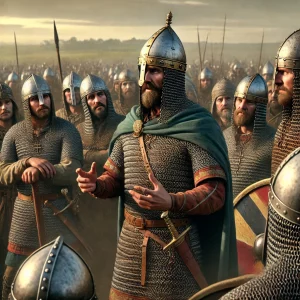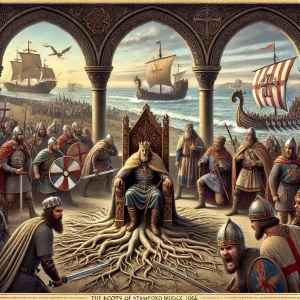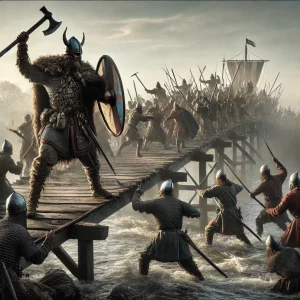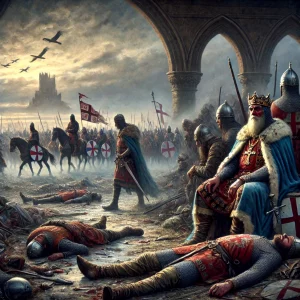The Battle of Stamford Bridge 1066
 As dawn broke on September 25, 1066, King Harold Godwinson received urgent news that the Viking invaders, led by the formidable Harald Hardrada, had landed in the north. The message was clear: the Vikings had captured York and were advancing swiftly. Without hesitation, Harold mustered his battle-weary troops and embarked on an astonishing forced march from London to Yorkshire, covering nearly 200 miles in just four days. This extraordinary feat of endurance set the stage for one of the most legendary battles in English history, a clash that would echo through the ages and shape the future of the nation.
As dawn broke on September 25, 1066, King Harold Godwinson received urgent news that the Viking invaders, led by the formidable Harald Hardrada, had landed in the north. The message was clear: the Vikings had captured York and were advancing swiftly. Without hesitation, Harold mustered his battle-weary troops and embarked on an astonishing forced march from London to Yorkshire, covering nearly 200 miles in just four days. This extraordinary feat of endurance set the stage for one of the most legendary battles in English history, a clash that would echo through the ages and shape the future of the nation.
The Battle of Stamford Bridge 1066 was a pivotal moment in English history, marking the end of the Viking Age and the beginning of a new era under Norman rule. This fierce confrontation between the English and the Norsemen was not just a military engagement; it was a dramatic turning point that changed the course of England’s destiny. How did this single battle alter the fate of a nation, and what can we learn from the bravery and strategy displayed on that fateful day?
The Road to Stamford Bridge
The roots of the Battle of Stamford Bridge 1066 lay in the tumultuous events following the death of King Edward the Confessor in January 1066. With no direct heir, the English throne became the prize in a fierce power struggle. Harold Godwinson, the powerful Earl of Wessex, was crowned king, but his claim was immediately contested. William of Normandy and Harald Hardrada of Norway both eyed the throne with ambition. Harald Hardrada, known as the “Last of the Vikings,” was one of the most feared warriors of his time. Seeking to reclaim the glory of his ancestors, he allied with Tostig, Harold’s exiled brother, who sought revenge against his sibling. Together, they assembled a formidable fleet and sailed for England, landing in Yorkshire. They quickly captured York and fortified their position, waiting for reinforcements. Unbeknown to them, King Harold and his army were marching north with incredible speed, determined to confront the invaders.
Confessor in January 1066. With no direct heir, the English throne became the prize in a fierce power struggle. Harold Godwinson, the powerful Earl of Wessex, was crowned king, but his claim was immediately contested. William of Normandy and Harald Hardrada of Norway both eyed the throne with ambition. Harald Hardrada, known as the “Last of the Vikings,” was one of the most feared warriors of his time. Seeking to reclaim the glory of his ancestors, he allied with Tostig, Harold’s exiled brother, who sought revenge against his sibling. Together, they assembled a formidable fleet and sailed for England, landing in Yorkshire. They quickly captured York and fortified their position, waiting for reinforcements. Unbeknown to them, King Harold and his army were marching north with incredible speed, determined to confront the invaders.
The Battle Unfolds
 On the morning of September 25, 1066, the English forces launched a surprise attack on the unsuspecting Vikings at Stamford Bridge. The sight of Harold’s army, appearing almost miraculously after their grueling march, took the Vikings by complete surprise. Initially, the Vikings were scattered, many without their armor as they had not expected battle that day. Harald Hardrada quickly rallied his men, and the battle commenced with brutal intensity. Both sides fought with ferocity, the air filled with the clash of swords and the cries of warriors. Harald Hardrada, towering above his men, fought with legendary valour until an arrow struck him in the throat, ending his life and shattering Viking morale. Tostig, too, met his end in the battle. The turning point came when the English managed to break the Viking shield wall, a formidable defensive formation. Amidst the chaos, a legendary moment unfolded as a lone Viking warrior held the narrow bridge against the English forces, delaying their advance and allowing his comrades to regroup. This act of heroism, though ultimately futile, became a symbol of Viking courage and determination.
On the morning of September 25, 1066, the English forces launched a surprise attack on the unsuspecting Vikings at Stamford Bridge. The sight of Harold’s army, appearing almost miraculously after their grueling march, took the Vikings by complete surprise. Initially, the Vikings were scattered, many without their armor as they had not expected battle that day. Harald Hardrada quickly rallied his men, and the battle commenced with brutal intensity. Both sides fought with ferocity, the air filled with the clash of swords and the cries of warriors. Harald Hardrada, towering above his men, fought with legendary valour until an arrow struck him in the throat, ending his life and shattering Viking morale. Tostig, too, met his end in the battle. The turning point came when the English managed to break the Viking shield wall, a formidable defensive formation. Amidst the chaos, a legendary moment unfolded as a lone Viking warrior held the narrow bridge against the English forces, delaying their advance and allowing his comrades to regroup. This act of heroism, though ultimately futile, became a symbol of Viking courage and determination.
Did You Know?
Did you know that a lone Viking warrior, armed only with an axe, is said to have held the narrow bridge at Stamford Bridge against the entire English army? This warrior, whose name has been lost to history, single-handedly delayed the English forces for hours, allowing the Viking army precious time to regroup. His bravery and sacrifice have become the stuff of legend, showcasing the indomitable spirit of the Viking warriors even in the face of overwhelming odds.
The Aftermath and Significance
The victory at The Battle of Stamford Bridge 1066 came at a great cost to King Harold and his forces. Though they had triumphed, the battle left them severely depleted and exhausted. Just three weeks later, Harold faced another invader, William of Normandy, at the Battle of Hastings. The weakened state of his army, worn down by the rapid march and the brutal fight at Stamford Bridge, played a crucial role in his defeat and the end of Anglo-Saxon rule in England. The Battle of Stamford Bridge, while a remarkable victory, set the stage for the Norman Conquest and the profound transformation of English society. From the perspective of an English soldier who fought at Stamford Bridge, the triumph was bittersweet. They had witnessed the end of the Viking threat but were soon thrust into another, even more challenging conflict. This battle, though a testament to their endurance and courage, ultimately marked the end of an era.
triumphed, the battle left them severely depleted and exhausted. Just three weeks later, Harold faced another invader, William of Normandy, at the Battle of Hastings. The weakened state of his army, worn down by the rapid march and the brutal fight at Stamford Bridge, played a crucial role in his defeat and the end of Anglo-Saxon rule in England. The Battle of Stamford Bridge, while a remarkable victory, set the stage for the Norman Conquest and the profound transformation of English society. From the perspective of an English soldier who fought at Stamford Bridge, the triumph was bittersweet. They had witnessed the end of the Viking threat but were soon thrust into another, even more challenging conflict. This battle, though a testament to their endurance and courage, ultimately marked the end of an era.
The Battle of Stamford Bridge was more than just a clash of swords; it was a turning point that heralded the end of one era and the beginning of another. It demonstrated the resilience and bravery of the English forces under King Harold and showcased the legendary courage of the Viking warriors. As historian Marc Morris puts it, “The Battle of Stamford Bridge was the last great triumph of the Anglo-Saxon military, but also its last stand.” This battle, fought with such valour on both sides, changed the course of English history and left a lasting legacy that still fascinates us today.
Find Out More!
- Books: “The Norman Conquest” by Marc Morris
- Websites: The British Library’s collection on the Norman Conquest
- Documentaries: BBC Teach “Battle of Stamford Bridge”
0 Comments